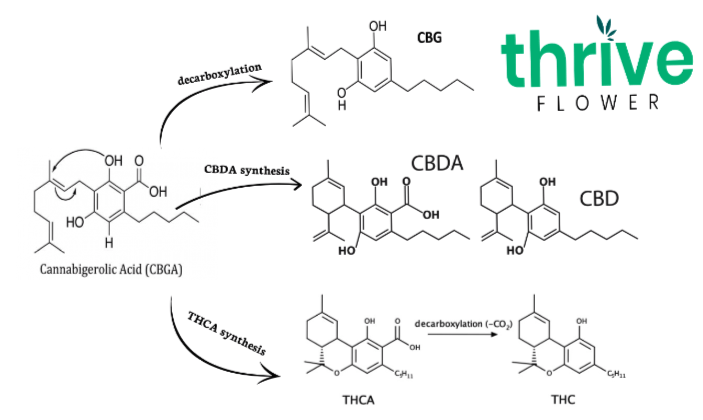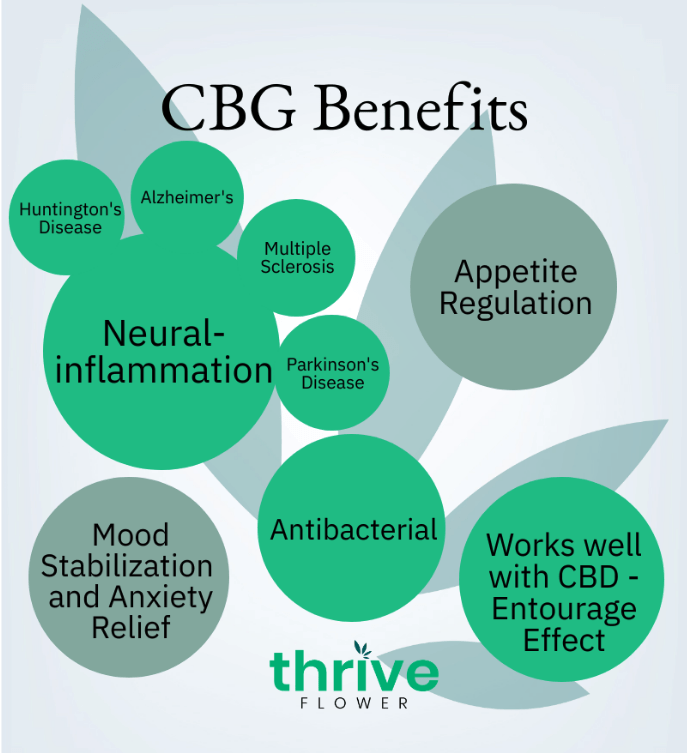What is CBG? Despite its expensive price tag, Cannabigerol (CBG) has gained popularity recently in the CBD wellness field. The studies on CBG are limited, but do show promise for the potential therapeutic treatment of conditions such as Anxiety, Multiple Sclerosis, Huntington’s Disease, Parkinson’s Disease, Alzheimers, Irritable Bowel Disease, and Glaucoma. CBG may also be able to help regulate appetite as well as help fight against drug-resistant bacteria.
Cannabinoids
A cannabinoid is a molecular compound made up of the active parts of the cannabis plant. So far, 113 cannabinoids have been identified. Tetrahydrocannabinol (THC) is the most commonly known cannabinoid. THC is the most abundant cannabinoid found in marijuana and is responsible for the feeling of being “high”. Cannabidiol (CBD) is another cannabinoid that has become popular. CBD is most abundantly found in the hemp plant. Legally, all CBD products must use CBD extracted from the hemp plant, not the mairjuana plant, because the hemp plant contains less than 0.3% THC and will not produce any psychoactive effects.
CBD is popular because it may provide many of the benefits associated with THC, but without the high. These benefits can include: anti-inflammation, pain management, sleep aid, anxiety relief, appetite/digestive help, and more. Cannabinoids work with your body by interacting with the Endocannabinoid System (ECS). Many physiological functions and processes are influenced by the ECS. This could be the immune response to inflammation or pain, combating anxiety, controlling appetite, sleep, etc. The goal of the ECS is to keep your body operating at a steady level of function called homeostasis.
So what is CBG exactly?…
Cannabigerol (CBG)
What is CBG?
Recently, more scarce cannabinoids such as cannabinol (CBN), cannabichromene (CBC), and cannabigerol (CBG) have risen in popularity. As with CBD, these cannabinoids will not produce a “high” feeling, but can provide wellness benefits.
Why is CBG Expensive?
Producing CBG isolate extract takes processing thousands of pounds of biomass just to produce a little bit. In a study on the effects of CBG, one kilogram (1kg) of dried cannabis flower produced only three grams (3g) of CBG isolate (0.3%) (Mazzon, et al). The availability of CBG in the cannabis plant is relatively much lower than other cannabinoids such as THC and CBD. This is where some science comes into play. Like THC and CBD, CBG comes from the mother of all cannabinoids: CBGA. The “A” in CBGA stands for acid. A process called decarboxylation removes the acid from the compound, leaving behind CBG.

What makes CBG so scarce is that CBGA can also become other cannabinoids besides CBG. CBGA can become CBDA or THCA, the acid forms of CBD and THC. The transformation of CBGA to other acids like CBDA and THCA occurs as the cannabis plant matures. When the plant is fully mature, however much CBGA is left can decarboxylize and become CBG. Usually this is less than 1% of the plant.
What CBG Does
Many wonder if CBG might be more effective than CBD for their specific affliction. The effects CBG has on anxiety, inflammation, sleep, appetite, and more, are still in the early stages of being studied. As we mentioned, like CBD, CBG interacts with the body’s Endocannabinoid System (ECS). CBG has been shown to be an “effective regulator of endocannabinoid signaling” (Franco, et al).
Does CBG Help Anxiety?
“Is CBD or CBG better for anxiety?”
Commonly people wonder if CBG can provide benefits for their anxiety. It was shown that CBG, like CBD, can interact with serotonin receptors (Tambaro, et al). Serotonin helps the body stabilize mood which could be related to anxiety relief. The discovery is promising, but the research on this particular benefit is limited and more studies are necessary to get a full grasp on CBG’s effect on anxiety. As for if CBD or CBG is better for anxiety relief, we cannot give a definite answer as we just do not know enough about it. User testimony seems to lead toward the feeling that they are both effective, but CBG may be faster acting.
Does CBG Help Pain?
Promising results have shown CBG to be a potential therapeutic avenue for dealing with pain and inflammation (Evans, et al). Neural-inflammation is the most studied effect CBG has shown. The “potent anti-inflammatory” effects of CBG could be effective in the treatment of Multiple Sclerosis (Bellido, et al), Huntington’s Disease, Alzheimer’s, and Parkinson’s Disease (Mazzon, et al). CBG works to reduce inflammation, in part, by restricting the production of pro-inflammatory cells in the body called cytokines. Decreasing inflammation is one of the most effective ways to reduce pain.
More CBG Benefits
CBG may have benefits for some other conditions, such as Glaucoma, Irritable Bowel Disease, as well as appetite regulation (Di Marzo, Et al) (Colasanti, et al) (Williams, et al). Cannabinoids, specifically CBG, have notable antibacterial properties that make them candidates for effective treatment of drug-resistant bacteria, specifically MRSA (methicillin-resistant Staphylococcus aureus) (Farha, et al).
The Entourage Effect
When multiple cannabinoids are used together, something called the Entourage Effect kicks in. The Entourage Effect states that the benefits of using the full-spectrum of cannabinoids outweigh the therapeutic benefits gained from just a single, isolated cannabinoid (Russo, et al). Many full-spectrum CBD products on the market contain some amount of CBG (as well as other cannabinoids like CBN and CBC).

How to Use CBG
CBG is not usually found as an isolated cannabinoid in a product, but rather paired with another cannabinoid, most commonly CBD. Full spectrum extracts contain the full range of cannabinoids found in the plant including CBD, CBG, CBC, CBN, and even THC. The levels of THC legally must be below 0.3% so that there will be no “high” feeling. CBG-targeted products may contain half CBD and half CBG as combination to achieve benefits from the entourage effect mentioned above.

The most common product you will find CBG in is tinctures. Tinctures are made of cannabinoid extract mixed with a carrier, usually MCT coconut oil. Placing a few drops of the tincture underneath your tongue or added to any food or beverage is a simple and effective way to take a dose of cannabinoids.

How to Find Quality CBG Products
When looking for any CBD, CBG, or other cannabinoid-containing products, there are a few things you can look for to make an informed decision. The product should come from who you deem to be a trustworthy company. This could be related to their customer service and their ability to answer any questions you may have. Buying from an informed company can help you navigate the expansive cannabinoid field and find what works best for you.
One important feature to keep an eye out for when viewing their webpage is lab-tested results from a third-party testing facility. The results should be easy to find and be up-to-date. They should show that the product contains the amount of cannabinoids that the label claims and that the levels of Δ9-THC are below the legal limit of 0.3%.



